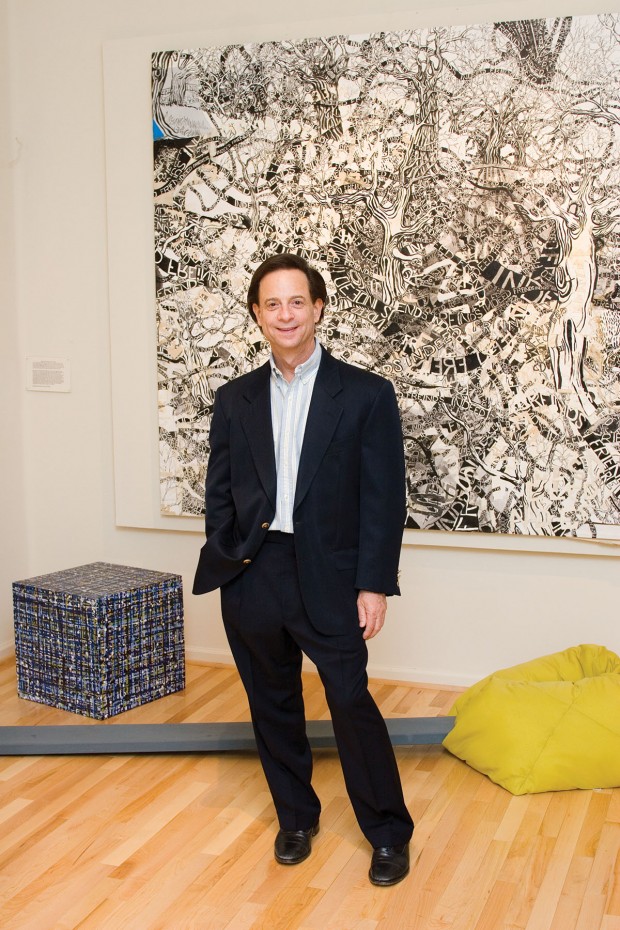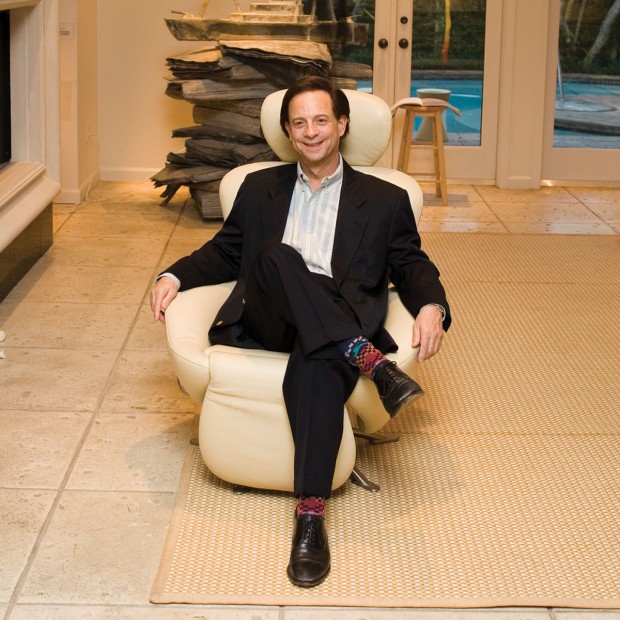Addicted to Art

Considered to be among the top 200 art collectors in the world and among the top 100 art collectors in the United States, Lester Marks says art has come to both define him and to energize him. (Photo: www.andrewsphoto.com)
For some of your neighbors, it’s a way of life. The art scene. Whether art deco, modern, abstract or contemporary, many resident art collectors feel fervently about their art collections. Here they share what’s behind their passion.
West U has a gem of an art collector in Lester Marks. Lester has been identified as one of the top 200 collectors in the world by ARTnews magazine and one of the top 100 in the US by Arts and Antiques magazine. A collector of contemporary art, Lester has been buying art for the last 15 years but only became “crazy” about collecting in the last six. He says that now “art defines my life—my friends, my associations, my outings, my vacations, everything relates to art. It has come to both define me and to energize me.”
His varied collection includes about 400 works by artists like Joseph Cornell, “who turns the simple into the sublime,” Jean Michel Basquiat, “who turns the weird into he wonderful,” and Robert Rauschenberg, “who turns the ordinary into the extraordinary.”
Lester looks for a specific feeling when he chooses art for his collection. “A good piece of art will truly move you,” he says. “I once read a great quote that said there are three kinds of art. Those that you see and say ‘Oh,’ those that you see and say ‘Oh my,’ and those that you see and say ‘Oh my Lord.’ I try to collect the third category.”
And it’s important for Lester to share his love of the arts with the rest of the community. He hosts dozens of fundraisers at his home each year for a variety of arts groups and brings high school and elementary school classes, senior care centers, and religious organizations to view his collection. As if that were not enough, for the past nine years he has underwritten free admission for all to the Contemporary Arts Museum of Houston, where he serves on the board.

Lester Marks is considered to be among the top 200 art collectors in the world and among the top 100 art collectors in the United States. At left, standing in front of Friends Indeed by artist Trenton Doyle Hancock. Above, seated in his West U home. (Photo: www.andrewsphoto.com)
West U’s Julie Kinzelman and her husband, Christopher Tribble, merged their art collection when they married. They currently own about 200 pieces spread throughout their home, in storage, and loaned out to museums.
Some of the highlights of their collection include a piece Julie commissioned from British artist David Batchelor—a multicolored piece made of 40 plastic detergent bottles that hangs in the front of their town home as a chandelier. But the piece “that gets the most people talking,” Julie says, is a suspended paper-maché type plane made from elements found in the artist’s studio that flies around the house with a 20-foot jet stream.
Julie explains why art is so important to the couple: “Art challenges our thought and increases our sense of awareness of the world in which we live. It forces us to view life with different eyes. For me, it’s kind of like breathing. I couldn’t imagine living without it.”
Candice Goodwin feels the same. She collects mostly local Houston abstract artists, including sculptor Susan Budge and painter Salli Babbitt. She has artwork spread throughout her home, and even painted her walls black to make the art pop. One of the most prominent pieces is an unusual metal kitchen table made out of a huge gear and wrenches. But Candice says it’s impossible to pick a favorite piece.
“There’s no favorite,” she says. “We love them all. We have a very varied, eclectic collection. Everything from abstract paintings to pieces made out of an old hairdryer case, etched aluminum, and melted glass blocks.”
Art is a lifelong love for Candice. “I was born with it as my passion,” she says. “It brings a richness to my life. I absolutely love to look at my pieces.”
But for those without a lifelong art interest or those who are not yet collectors but would like to get into the art scene, Houston art consultant Julie Kinzelman recognizes that the process can seem overwhelming. Through her business, Kinzelman Art Consulting, Julie assists clients in acquiring work for a collection.
“Starting a collection can be very intimidating,” Julie says. “I encourage people to spend as much time as possible just looking in museums, studios, or galleries looking at works and examining what is most meaningful to them before making an acquisition. You should apply the same philosophy to buying a piece of art that you would to buying a car or a TV—do some research.”
Candice also suggests visiting museums and galleries, getting on their mailing lists, and attending art openings, as well as, enrolling in one of the city’s many classes that teach how to look at art.
Julie’s advice to wanna-be art collectors? “Think about what you respond to emotionally and conceptually,” Julie says. “Art is most powerful when it creates a response in you.”
Want more buzz like this? Sign up for our Morning Buzz emails.
To leave a comment, please log in or create an account with The Buzz Magazines, Disqus, Facebook, or Twitter. Or you may post as a guest.


